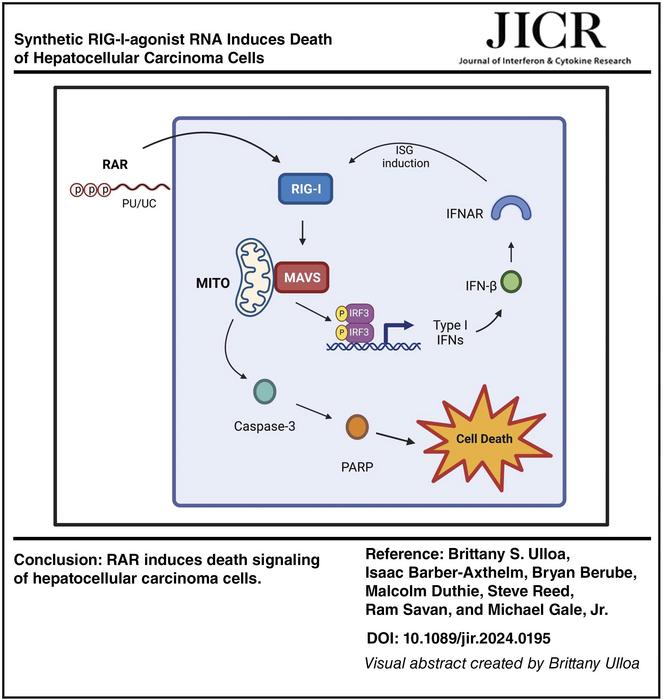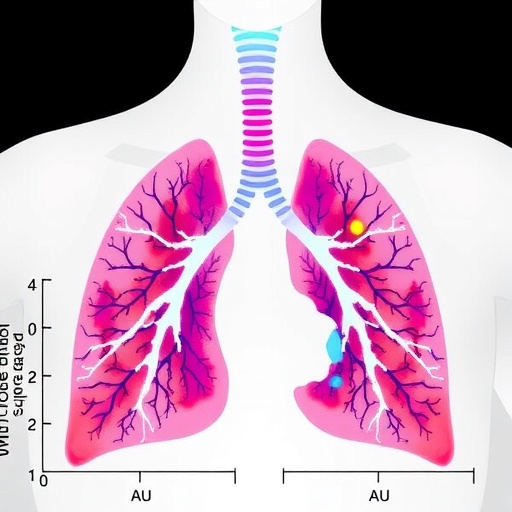
A team of researchers from the University of Washington School of Medicine has unveiled groundbreaking findings in the fight against hepatocellular carcinoma (HCC), a prevalent form of liver cancer. Their study, published in the esteemed Journal of Interferon & Cytokine Research, highlights the remarkable potential of a synthetic retinoic acid-inducible gene I (RIG-I) agonist RNA. This molecule, designated as RAR, has shown the ability to both activate innate immune responses and induce cell death specifically in HCC cells, as demonstrated in laboratory experiments.
The RAR molecule is a modified RNA motif, intricately designed to mimic components found in the hepatitis C virus genome. When introduced into human hepatocellular carcinoma cell lines, RAR elicited a strong response from the immune system, notably triggering the production of interferon beta (IFN-β), a critical mediator in fighting viral infections and tumor proliferation. The synthesis of this molecule holds promise not only for its immediate effects on cancer cells but also for fostering a broader immune response.
The experimental outcomes reported by the research team underscore a dual mechanism of action. The RNA-induced cell death seen in hepatoma cells was further enhanced by administering recombinant IFN-β alongside RAR. This additive effect indicates that the combination could represent a new therapeutic approach, leveraging the immune system’s capabilities while directly targeting cancerous cells. Researchers are optimistic that this therapeutic strategy could pave the way for innovative treatments for HCC and perhaps other malignancies.
As cancer continues to pose a significant global health challenge, the discovery of agents that stimulate innate immune responses offers a beacon of hope. The findings suggest an encouraging model for how RAR can lead to programmed cell death in hepatocellular carcinoma. Such pathways are vital not only for the treatment of existing cancers but could also prevent recurrence after surgery or traditional therapies. This reinforces the necessity for ongoing research into the immune system’s role in cancer therapeutics.
The significance of targeting the innate immune system in cancer treatment cannot be overstated, especially as researchers aim to improve patient outcomes and reduce side effects associated with conventional therapies like chemotherapy. The study’s principal investigator, Michael Gale, Jr., articulates a vision where therapies such as RAR might play a prominent role in comprehensive cancer care, heralding a new era where synthetic biology can address such profound health challenges.
Moreover, the research points to the broader implications of RIG-I activation beyond hepatocellular carcinoma. The capacity of RIG-I agonists to induce immune activation could also be explored in various cancers, potentially allowing for tailored immunotherapeutic approaches that capitalize on this vulnerability. By harnessing the body’s innate immune responses, scientists hope to unlock new avenues for combating not just HCC, but a myriad of difficult-to-treat malignancies.
The study utilized two distinct human hepatocellular carcinoma cell lines for testing RAR’s effects. This diversity in the experimental model is crucial, as it aids in validating results across varying biological conditions. Such rigorous methodologies ensure that the conclusions drawn are not merely due to chance or unique to one particular cell line, enhancing the reliability and applicability of the findings in future clinical scenarios.
Furthermore, the mechanism behind the action of RAR involves interaction with specific receptor systems in cells that underlie key signaling pathways essential for cell survival and death. By elucidating these pathways, the research lays the groundwork for subsequent studies that may examine combinational therapies or sequential treatment regimens involving RAR and other immune modulators. This could create robust treatment plans that maximize efficacy while minimizing the potential for resistance.
The implications of the research extend to the realm of drug development. The design and characterization of RAR provide insights for the synthesis of novel compounds aimed at various targets within the immune system’s arsenal. As the field of immuno-oncology continues to evolve, the success of RAR could inspire a series of new therapeutic agents, each tailored to specific malignancies and patient needs.
It’s essential to underscore that while this study presents promising data, further investigation in preclinical and clinical phases is necessary to validate RAR’s safety and efficacy in human subjects. The transition from the lab bench to the clinic remains a complex journey, marred by the challenges of translating laboratory successes into real-world patient benefits.
The insights derived from this innovative research have not gone unnoticed in the academic community. Peer feedback has highlighted the quality and potential impact of the findings, suggesting that RAR and similar molecules may inject new life into the quest for effective therapies against liver cancer and possibly broader types of cancer. Such recognition underscores the importance of continual support for research endeavors that strive to push the boundaries of current medical understanding and practices.
In conclusion, the study on RIG-I agonist RNA embodies the spirit of innovation in cancer research. As scientists continue to explore the intersections between cancer biology and immunology, the potential for breakthroughs like RAR shines brightly. With proper funding, collaboration, and attention, this research could spotlight pathways leading to effective therapies and perhaps a future where cancer is not only treatable but preventable.
Subject of Research: Cells
Article Title: Synthetic RIG-I-Agonist RNA Induces Death of Hepatocellular Carcinoma Cells
News Publication Date: February 19, 2025
Web References: Journal of Interferon & Cytokine Research
References: DOI: 10.1089/jir.2024.0195
Image Credits: Credit: Published in Journal of Interferon & Cytokine Research, copyright 2025, Mary Ann Liebert, Inc.
Keywords: Clinical research, Interferons, Hepatocellular carcinoma, RNA mechanisms, Immune response.
Tags: apoptosis in cancer cellsdual mechanism of actionhepatitis C virus mimicryhepatocellular carcinoma treatmentimmune response activationinnovative oncology solutionsinterferon beta productionlaboratory cancer researchnovel cancer therapiesRNA-based cancer treatmentssynthetic RIG-I agonist RNAUniversity of Washington research





